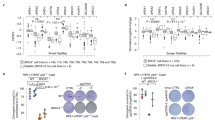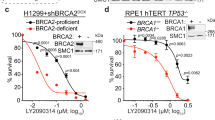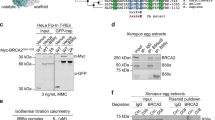Abstract
The oncogenic kinase AKT1 is frequently overexpressed or activated in sporadic breast and ovarian cancers. In human breast tumors, we have previously shown that AKT1 represses homologous recombination (HR) induced by one double-strand break (DSB). To further analyze the impact of AKT1 on HR, we ectopically expressed wild-type or mutant forms of AKT1 in a hamster ovary cell line containing an intrachromosomal substrate for monitoring HR. In this cell line, AKT1 repressed HR induced by different genotoxic stresses including ionizing radiation, UV-C and one single DSB introduced into the intrachromosomal substrate. Consistently, AKT1 disrupted RAD51 foci formation, showing that AKT1 specifically affects gene conversion. Concomitantly, AKT1 represses both BRCA1 foci formation and HR stimulation resulting from BRCA1 overexpression, showing that AKT1 affects BRCA1-mediated HR functions, also in another species (hamster) and in another type of cell tissue (ovary cells). Finally, consistent with the HR defects, active AKT1 expression induces supernumerary centrosomes and aneuploidy. In addition to its impact on cell proliferation and apoptosis, the present data propose a novel oncogenic function for AKT1, by producing genomic instability as a consequence of HR repression.
This is a preview of subscription content, access via your institution
Access options
Subscribe to this journal
Receive 50 print issues and online access
$259.00 per year
only $5.18 per issue
Buy this article
- Purchase on Springer Link
- Instant access to full article PDF
Prices may be subject to local taxes which are calculated during checkout





Similar content being viewed by others
References
Altiok S, Batt D, Altiok N, Papautsky A, Downward J, Roberts TM et al. (1999). Heregulin induces phosphorylation of BRCA1 through phosphatidylinositol 3-Kinase/AKT in breast cancer cells. J Biol Chem 274: 32274–32278.
Aten JA, Stap J, Krawczyk PM, van Oven CH, Hoebe RA, Essers J et al. (2004). Dynamics of DNA double-strand breaks revealed by clustering of damaged chromosome domains. Science 303: 92–95.
Bertrand P, Lambert S, Joubert C, Lopez BS . (2003). Overexpression of mammalian Rad51 does not stimulate tumorigenesis while a dominant-negative Rad51 affects centrosome fragmentation, ploidy and stimulates tumorigenesis, in p53-defective CHO cells. Oncogene 22: 7587–7592.
Daboussi F, Thacker J, Lopez BS . (2005). Genetic interactions between RAD51 and its paralogues for centrosome fragmentation and ploidy control, independently of the sensitivity to genotoxic stresses. Oncogene 24: 3691–3696.
Deans B, Griffin CS, O'Regan P, Jasin M, Thacker J . (2003). Homologous recombination deficiency leads to profound genetic instability in cells derived from Xrcc2-knockout mice. Cancer Res 63: 8181–8187.
Deng CX . (2002). Roles of BRCA1 in centrosome duplication. Oncogene 21: 6222–6227.
Griffin CS, Simpson PJ, Wilson CR, Thacker J . (2000). Mammalian recombination-repair genes XRCC2 and XRCC3 promote correct chromosome segregation. Nat Cell Biol 2: 757–761.
Haaf T, Golub EI, Reddy G, Radding CM, Ward DC . (1995). Nuclear foci of mammalian Rad51 recombination protein in somatic cells after DNA damage and its localization in synaptonemal complexes. Proc Natl Acad Sci USA 92: 2298–2302.
Hinton CV, Fitzgerald LD, Thompson ME . (2007). Phosphatidylinositol 3-kinase/Akt signaling enhances nuclear localization and transcriptional activity of BRCA1. Exp Cell Res 313: 1735–1744.
Hut HM, Lemstra W, Blaauw EH, Van Cappellen GW, Kampinga HH, Sibon OC . (2003). Centrosomes split in the presence of impaired DNA integrity during mitosis. Mol Biol Cell 14: 1993–2004.
Ivanov EL, Sugawara N, Fishman-Lobell J, Haber JE . (1996). Genetic requirements for the single-strand annealing pathway of double-strand break repair in Saccharomyces cerevisiae. Genetics 142: 693–704.
Kraakman-van der Zwet M, Overkamp WJ, van Lange RE, Essers J, van Duijn-Goedhart A, Wiggers I et al. (2002). Brca2 (XRCC11) deficiency results in radioresistant DNA synthesis and a higher frequency of spontaneous deletions. Mol Cell Biol 22: 669–679.
Lambert S, Lopez BS . (2000). Characterization of mammalian RAD51 double strand break repair using non lethal dominant negative forms. EMBO J 19: 3090–3099.
Lambert S, Lopez BS . (2002). Inactivation of the RAD51 recombination pathway stimulates UV-induced mutagenesis in mammalian cells. Oncogene 21: 4065–4069.
Lee H, Trainer AH, Friedman LS, Thistlethwaite FC, Evans MJ, Ponder BA et al. (1999). Mitotic checkpoint inactivation fosters transformation in cells lacking the breast cancer susceptibility gene, Brca2. Mol Cell 4: 1–10.
Lee SE, Moore JK, Holmes A, Umezu K, Kolodner RD, Haber JE . (1998). Saccharomyces Ku70, mre11/rad50 and RPA proteins regulate adaptation to G2/M arrest after DNA damage. Cell 94: 399–409.
Liang F, Han M, Romanienko PJ, Jasin M . (1998). Homology-directed repair is a major double-strand break repair pathway in mammalian cells. Proc Natl Acad Sci USA 95: 5172–5177.
Liu N, Lamerdin JE, Tebbs RS, Schild D, Tucker JD, Shen MR et al. (1998). XRCC2 and XRCC3, new human Rad51-family members, promote chromosome stability and protect against DNA cross-links and other damages. Mol Cell 1: 783–793.
Miralem T, Avraham HK . (2003). Extracellular matrix enhances heregulin-dependent BRCA1 phosphorylation and suppresses BRCA1 expression through its C terminus. Mol Cell Biol 23: 579–593.
Narod SA, Foulkes WD . (2004). BRCA1 and BRCA2: 1994 and beyond. Nat Rev Cancer 4: 665–676.
Plo I, Laulier C, Gauthier L, Lebrun F, Calvo F, Lopez BS. (2008). AKT1 inhibits homologous recombination by inducing cytoplasmic retention of BRCA1 and RAD51. Cancer Res 68: 9404–9412.
Saintigny Y, Delacote F, Boucher D, Averbeck D, Lopez BS. (2007). XRCC4 in G1 suppresses homologous recombination in S/G2, in G1 checkpoint-defective cells. Oncogene 26: 2769–2780.
Saintigny Y, Rouillard D, Chaput B, Soussi T, Lopez BS . (1999). Mutant p53 proteins stimulate spontaneous and radiation-induced intrachromosomal homologous recombination independently of the alteration of the transactivation activity and of the G1 checkpoint. Oncogene 18: 3553–3563.
Sonoda E, Sasaki MS, Buerstedde JM, Bezzubova O, Shinohara A, Ogawa H et al. (1998). Rad51-deficient vertebrate cells accumulate chromosomal breaks prior to cell death. EMBO J 17: 598–608.
Sun M, Wang G, Paciga JE, Feldman RI, Yuan ZQ, Ma XL et al. (2001). AKT1/PKBalpha kinase is frequently elevated in human cancers and its constitutive activation is required for oncogenic transformation in NIH3T3 cells. Am J Pathol 159: 431–437.
Takata M, Sasaki MS, Tachiiri S, Fukushima T, Sonoda E, Schild D et al. (2001). Chromosome instability and defective recombinational repair in knockout mutants of the five Rad51 paralogs. Mol Cell Biol 21: 2858–2866.
Venkitaraman AR . (2002). Cancer Susceptibility and the Functions of BRCA1 and BRCA2. Cell 108: 171–182.
Wang YY, Maher VM, Liskay RM, McCormick JJ . (1988). Carcinogens can induce homologous recombination between duplicated chromosomal sequences in mouse L cells. Mol Cell Biol 8: 196–202.
Xiang T, Ohashi A, Huang Y, Pandita TK, Ludwig T, Powell SN et al. (2008). Negative Regulation of AKT Activation by BRCA1. Cancer Res 68: 10040–10044.
Xu X, Weaver Z, Linke SP, Li C, Gotay J, Wang XW et al. (1999). Centrosome amplification and a defective G2-M cell cycle checkpoint induce genetic instability in BRCA1 exon 11 isoform-deficient cells. Mol Cell 3: 389–395.
Yang H, Wen YY, Zhao R, Lin YL, Fournier K, Yang HY et al. (2006). DNA damage-induced protein 14-3-3 sigma inhibits protein kinase B/Akt activation and suppresses Akt-activated cancer. Cancer Res 66: 3096–3105.
Zhang J, Willers H, Feng Z, Ghosh JC, Kim S, Weaver DT et al. (2004). Chk2 phosphorylation of BRCA1 regulates DNA double-strand break repair. Mol Cell Biol 24: 708–718.
Acknowledgements
We thank Dr Hemmings (Friedrich Miescher Institute, Basel, Switzerland) for providing us the wtAKT1, myrAKT1 and kdAKT1 expression vectors, and Dr Jasin (Sloan-Kettering Institute, NYC, USA) for providing us with the CHO-DRA10 cell line and the I-SceI expression plasmid. This work was supported by La Ligue Nationale contre le Cancer ‘Equipes labellisées, La Ligue 2005 and 2008’ and by l'Agence Nationale de la Recherche. IP was a recipient of an ARC fellowship.
Author information
Authors and Affiliations
Corresponding author
Additional information
Supplementary Information accompanies the paper on the Oncogene website (http://www.nature.com/onc)
Rights and permissions
About this article
Cite this article
Plo, I., Lopez, B. AKT1 represses gene conversion induced by different genotoxic stresses and induces supernumerary centrosomes and aneuploidy in hamster ovary cells. Oncogene 28, 2231–2237 (2009). https://doi.org/10.1038/onc.2009.85
Received:
Revised:
Accepted:
Published:
Issue Date:
DOI: https://doi.org/10.1038/onc.2009.85



